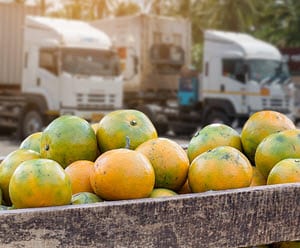
The guide to keeping it cool with reefer logistics

From the perfectly ripe Australian avocado enjoyed in winter to the life-saving vaccines reaching remote locations, ensuring the safe and timely arrival of perishable goods across vast distances is a logistical feat.
Fortunately, reefer logistics solves this challenge by providing the specialized transportation and storage needed for temperature-sensitive goods. These products in the cold chain logistics can range from perishable foods like fruits, vegetables, meat, and dairy products to pharmaceuticals, chemicals, and even certain types of electronics.
Keeping it chill: How do reefer containers work?
Reefer containers, short for refrigerated containers, are essentially giant refrigerators that keep cargo at specific temperatures to maintain their quality and safety throughout the supply chain.
Here is a breakdown of how reefer containers work:
1. Cooling system
A refrigeration unit, mounted on one end of the container, is the heart of the system. This unit uses a compressor, condenser, evaporator, and refrigerant like a typical refrigerator.
When plugged into a power source, the compressor circulates a refrigerant, which absorbs heat from the container's interior air as it passes through the evaporator coils. The chilled air is then blown into the container by fans within the refrigeration unit.
2. Air circulation
Reefer containers have a specially designed T-floor with channels that evenly distribute the chilly air throughout the bottom. Since cool air sinks, it naturally rises through the cargo, absorbing heat and maintaining a consistent temperature.
Warm air eventually makes its way back to the front of the container, where it gets sucked back into the refrigeration unit to be chilled again, creating a continuous circulation loop.
3. Temperature control
Different perishables have specific temperature needs. Fruits and vegetables often require chilled environments, while meats and seafood demand freezing temperatures. This is why reefer containers offer a wide range of temperature control, typically between -30°C to +30°C. The desired temperature is set on a control panel inside the container and the unit automatically regulates the cooling process to maintain this suitable temperature.
Some cargo, such as fruits and vegetables, benefit from controlled humidity to prevent spoilage. The refrigeration unit may have a dehumidification function to remove excess moisture from the air. For instance, DHL’s reefer containers are equipped with a humidity control function to avoid fungi, mold, and dehydration. Humidity levels can be set between 50 percent and 95 percent relative humidity, while dehumidification can only be set for temperatures above or equal to negative 10°C.
Ventilation is another crucial aspect. Certain cargo types require fresh air exchange to remove the respiratory gases they emit during transport. Reefer units can be adjusted to allow for controlled air exchange.
What are the chilly challenges in reefer logistics?
Reefer logistics faces a frosty battle with various problems, such as consistently maintaining temperatures, human error, and environmental concerns.
1. Maintenance of consistent temperature & humidity
Reefer containers need a constant power source to maintain the desired temperature range and prevent humidity build-up. This can be a challenge during transport when switching between power sources (genset, electrical plugs) and at container yards where space with proper electrical supply might be limited.
Additionally, malfunctioning refrigeration systems can lead to cargo spoilage if temperatures fluctuate or proper air circulation is not maintained.
The easiest solution to this problem is implementing a preventative maintenance program to identify and address potential issues before reefer units cause problems.
Shippers can also consider investing in Internet of Things (IoT) sensors that monitor temperature, humidity, and other critical parameters in real-time. Apart from internal and external container temperature and humidity levels, IoT sensor data allows users to monitor the door opening/closing status of the storage unit, fuel levels of generator sets, as well as the power source status of grids versus generators.
This real-time data allows for timely adjustments to maintain optimal conditions and prevent spoilage.
2. Human errors in manual processes
Reefer operations are also labor-intensive, requiring manual plugging/unplugging of containers, monitoring, and data logging. This leaves room for human error and potential disruptions in the cold chain if procedures are not followed precisely.
To tackle this issue, automate processes wherever possible. For instance, using automated plugging/unplugging systems, real-time data collection, and digital documentation minimizes errors and improves data accuracy.
3. Environmental concerns
Lastly, there is pressure on reefer logistics to become more sustainable. Traditional diesel-powered units and empty return trips contribute to a significant environmental footprint.
While the industry is responding by exploring alternative biofuels and using advanced software to optimize routes, shippers should consider if their goods really need reefer containers. Not all shipments require the full features of a reefer container and may benefit from reefer alternatives like insulated containers and cooling agents.
Do not get cold feet: The future of reefer logistics
With the global cold chain logistics market projected to experience a staggering 13 percent compounded annual growth rate and snowballing to a value of US$862.33 billion by 2032, there's a clear and growing demand for efficient cold chain solutions. This growth is fueled by rising consumer demand for fresh and healthy food, the expansion of e-commerce for perishables, and the flourishing pharmaceutical industry.
So, how can businesses stay ahead of the curve and avoid getting left out in the cold?
Companies can capitalize on this trend by embracing strategic partnerships. Collaborating with experienced cold chain logistics providers will be crucial to providing the necessary expertise and infrastructure.
After all, in an ever-changing world, adaptation is a recipe for success, if not survival.
ALSO WORTH READING
















 English
English